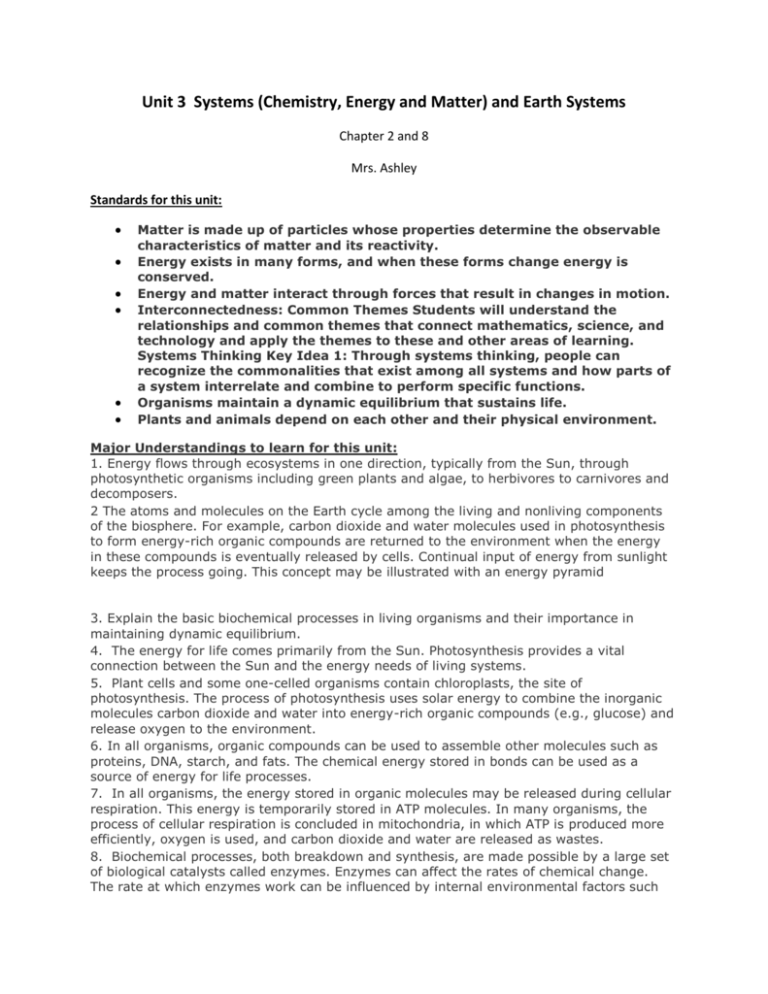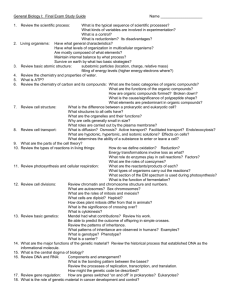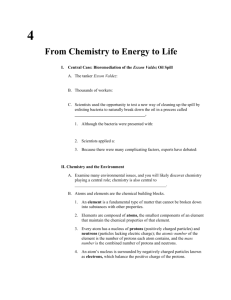Unit 3 Systems (Chemistry, Energy and Matter)
advertisement

Unit 3 Systems (Chemistry, Energy and Matter) and Earth Systems Chapter 2 and 8 Mrs. Ashley Standards for this unit: Matter is made up of particles whose properties determine the observable characteristics of matter and its reactivity. Energy exists in many forms, and when these forms change energy is conserved. Energy and matter interact through forces that result in changes in motion. Interconnectedness: Common Themes Students will understand the relationships and common themes that connect mathematics, science, and technology and apply the themes to these and other areas of learning. Systems Thinking Key Idea 1: Through systems thinking, people can recognize the commonalities that exist among all systems and how parts of a system interrelate and combine to perform specific functions. Organisms maintain a dynamic equilibrium that sustains life. Plants and animals depend on each other and their physical environment. Major Understandings to learn for this unit: 1. Energy flows through ecosystems in one direction, typically from the Sun, through photosynthetic organisms including green plants and algae, to herbivores to carnivores and decomposers. 2 The atoms and molecules on the Earth cycle among the living and nonliving components of the biosphere. For example, carbon dioxide and water molecules used in photosynthesis to form energy-rich organic compounds are returned to the environment when the energy in these compounds is eventually released by cells. Continual input of energy from sunlight keeps the process going. This concept may be illustrated with an energy pyramid 3. Explain the basic biochemical processes in living organisms and their importance in maintaining dynamic equilibrium. 4. The energy for life comes primarily from the Sun. Photosynthesis provides a vital connection between the Sun and the energy needs of living systems. 5. Plant cells and some one-celled organisms contain chloroplasts, the site of photosynthesis. The process of photosynthesis uses solar energy to combine the inorganic molecules carbon dioxide and water into energy-rich organic compounds (e.g., glucose) and release oxygen to the environment. 6. In all organisms, organic compounds can be used to assemble other molecules such as proteins, DNA, starch, and fats. The chemical energy stored in bonds can be used as a source of energy for life processes. 7. In all organisms, the energy stored in organic molecules may be released during cellular respiration. This energy is temporarily stored in ATP molecules. In many organisms, the process of cellular respiration is concluded in mitochondria, in which ATP is produced more efficiently, oxygen is used, and carbon dioxide and water are released as wastes. 8. Biochemical processes, both breakdown and synthesis, are made possible by a large set of biological catalysts called enzymes. Enzymes can affect the rates of chemical change. The rate at which enzymes work can be influenced by internal environmental factors such as pH and temperature. 9. Explain chemical bonding in terms of the motion of electrons. 10. Chemical bonds are formed when valence electrons are: • transferred from one atom to another (ionic) • shared between atoms (covalent) • mobile within a metal (metallic) 11. Energy can exist in different forms, such as chemical, electrical, electromagnetic, thermal, mechanical, nuclear. 12. Each atom has a nucleus, with an overall positive charge, surrounded by negatively charged electrons. 13. Subatomic particles contained in the nucleus include protons and neutrons. 14. The proton is positively charged, and the neutron has no charge. The electron is negatively charged. 15. Protons and electrons have equal but opposite charges. The number of protons equals the number of electrons in an atom. 16. .1f The mass of each proton and each neutron is approximately equal to one atomic mass unit. An electron is much less massive than a proton or a neutron. 17. The number of protons in an atom (atomic number) identifies the element. The sum of the protons and neutrons in an atom (mass number) identifies an isotope. Common notations that represent isotopes include: 14C, 14C, carbon-14, C-14. 18. Atoms of an element that contain the same number of protons but a different number of neutrons are called isotopes of that element. 19.The average atomic mass of an element is the weighted average of the masses of its naturally occurring isotopes. 20. Matter is classified as a pure substance or as a mixture of substances. Major Understanding 3.1r Apure substance (element or compound) has a constant composition and constant properties throughout a given sample, and from sample to sample. 21. Elements are substances that are composed of atoms that have the same atomic number. Elements cannot be broken down by chemical change. 22. A compound is a substance composed of two or more different elements that are chemically combined in a fixed proportion. A chemical compound can be broken down by chemical means. A chemical compound can be represented by a specific chemical formula and assigned a name based on the IUPAC system. 23. Organic compounds contain carbon atoms, which bond to one another in chains, rings, and networks to form a variety of structures. Organic compounds can be named using the IUPAC system. 24. Hydrocarbons are compounds that contain only carbon and hydrogen. Saturated hydrocarbons contain only single carbon-carbon bonds. Unsaturated hydrocarbons contain at least one multiple carbon-carbon bond. 25. The three phases of matter (solids, liquids, and gases) have different properties. 26. Systems in nature tend to undergo changes toward lower energy and higher entropy. 27. The acidity or alkalinity of an aqueous solution can be measured by its pH value. The relative level of acidity or alkalinity of these solutions can be shown by using indicators. 28. On the pH scale, each decrease of one unit of pH represents a tenfold increase in hydronium ion concentration. 29. Use atomic and molecular models to explain common chemical reactions. 30. A physical change results in the rearrangement of existing particles in a substance. A chemical change results in the formation of different substances with changed properties. Topics: Systems, the earth as a system Flow of matter and energy in the environment Basic chemistry Ecosystem Services Ecosystem productivity Trophic levels Resistance and resilience of ecosystems Soil Plate Tectonics Rock Cycle Mineral Resources Begin study on Envirothon: Tree Diseases, Height of a tree DBH, Measuring Board ft, fish and macroinvertebrate identification, Tree Identification, Prepare for Aquatics section Labs and Projects for Unit 3 Weather data (on-going) Soil organisms lab Soil lab Water Quality at Teatown (on-going) Mining Simulation Winograsky Column Trout tank for trout release Forestry practices, defining forestry structures Out of Class Assignments and Due Dates: 1. Read chapter 2 (due Thursday, November 1) 2. View Ms. Riche's PowerPoint on Chemistry, write down questions you have that need more explanation on November 1 3. View Mrs. Ashley's PowerPoint on Energy, write down questions you have that need more explanation and bring to class on November 2 4. Do one of the following for chapter 3: (due November 5; you may do more than one for extra credit) A. Vocabulary for chapter 3 B. Review questions for chapter 3 C. Write an essay on the concept of: "There is no away" on planet earth. In your essay relate the concept to the ideas presented in chapter 3 about matter and energy . Discuss the United States throwaway mentality and its affect on the concept of there is no away. 5. Do workbook pages: 52-53; 6. Read Chapter 8 (due Thursday, November 8) 7. View Mrs. Ashley's PowerPoint on Chapter 8 and write down any questions you have, bring the questions in to class on November 8 Do work book pages 10-24; 147-148 8. Do one of the following for chapter 8 (Due November 9)(You may do more than one for extra credit) A. Vocabulary B. Review Questions C. Do the Plate Tectonic activity on Maps D. Create a poster or brochure of the rock cycle E. Investigate the issues with Fracking in New York. Prepare a position statement with factual evidence either against or for fracking in New York State. 9. Do the soil webquest (due November 12) 10. Test on Unit 3, November 12)











